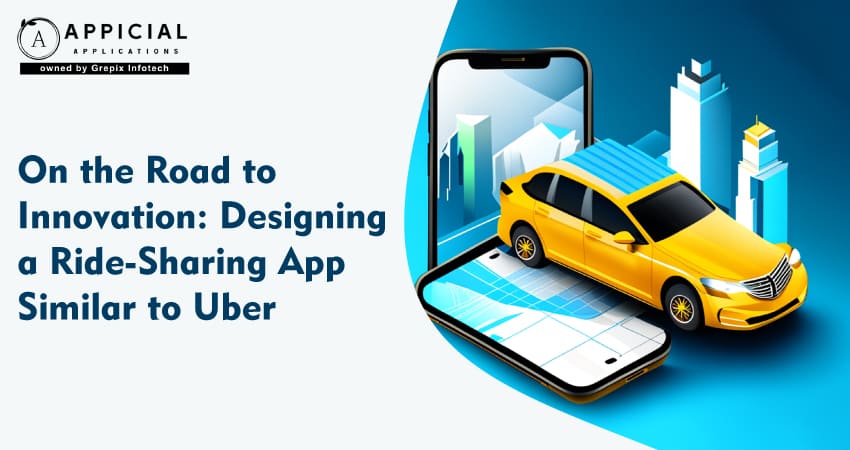
On the Road to Innovation: Designing a Ride-Sharing App Similar to Uber
In an era where convenience and efficiency reign supreme, ride-sharing apps have emerged as a cornerstone of modern urban transportation. Companies like Uber have not only transformed how we travel but have also paved the way for a surge of innovations within the tech-driven transportation sector. As we consider launching a new ride-sharing service, it's crucial to go beyond mere imitation and strive for innovation, creating a platform that not only meets current market demands but also anticipates future needs.
This blog explores the multifaceted journey of designing a ride-sharing app similar to Uber—from initial market research to the final touches of user experience design—highlighting key strategies, technological tools, and creative insights needed to navigate this competitive industry successfully. Whether you are a budding entrepreneur, a software developer, or simply a tech enthusiast, this guide aims to illuminate the path towards creating a service that is both influential and innovative in the world of ride-sharing.
The blog "On the Road to Innovation: Designing a Ride-Sharing App Similar to Uber" outlines the comprehensive steps necessary for creating a competitive ride-sharing app. It covers essential phases such as in-depth market research to identify customer needs and competitive gaps, selecting the appropriate technology stack for scalable and efficient performance, and designing a user-friendly interface that enhances customer satisfaction and retention. Key strategies also include navigating complex regulatory environments to ensure compliance and safety, implementing advanced features using AI and eco-friendly options to enhance user experience, and robust testing phases to refine the app before launch. The blog emphasizes the importance of ongoing marketing strategies to attract and retain users, alongside continuous improvement based on user feedback and technological advances to maintain relevance in the dynamic ride-sharing industry.
Understanding the Market
Understanding the market is the foundational step in designing a ride-sharing app that can compete with leaders like Uber. This process involves comprehensive research aimed at defining your target audience, assessing the competitive landscape, and identifying unique opportunities for differentiation and value addition. Here’s how you can approach this crucial phase:
- Who are your potential users? Understand their commuting patterns, preferences, and pain points.
- What do competitors offer? Look at existing services like Uber, Lyft, and regional players. Identify gaps in their offerings.
- What can you do differently? Whether it’s pricing, features, user experience, or niches like eco-friendliness, find your unique selling proposition (USP)
Selecting the Right Technology Stack
Choosing the appropriate technology stack is crucial for the robust performance and scalability of your ride-sharing app. This involves selecting the right tools and platforms for both the client-side and server-side components.
Frontend Technologies
- Mobile Development: Choose between native development (Swift for iOS, Kotlin for Android) and cross-platform solutions (React Native, Flutter). Consider your target audience and the specific features you plan to offer.
Backend Technologies
- Server, Networking, and Database: Robust choices might include Node.js or Python for server-side logic; PostgreSQL or MongoDB for databases; and AWS or Azure for cloud services. The backend should efficiently handle concurrent user requests and real-time data processing.
APIs and Middleware
- Google Maps API: Essential for route mapping and navigation.
- Payment Gateway Integration: Secure API integrations for payments, like Stripe or PayPal, are critical.
- SMS and Push Notifications: For user verification and real-time updates, consider services like Twilio or Firebase.
Designing the User Experience
Designing an exceptional user experience (UX) is crucial for the success of any ride-sharing app, as it directly influences user satisfaction and retention rates. The UX should be intuitive and efficient, ensuring that from the moment users download the app to when they complete their ride, every interaction is seamless and hassle-free. This includes a straightforward onboarding process, a simple and clean interface that allows users to book a ride in just a few taps, and clear communication throughout the user journey. By prioritizing user experience design, you not only meet the functional needs of your customers but also create a positive emotional connection to your brand, which is vital in a competitive market.
UX Design Principles
- Simplicity and Intuitiveness: Ensure the app interface is easy to use. The fewer taps to book a ride, the better.
- Accessibility: Design with all users in mind, including those with disabilities. This can involve voice commands, high-contrast visuals, and more.
- Feedback and Interaction: Timely feedback, such as notifications about ride status and dynamic fare estimates, enhance user engagement.
UI Design
- Visual Appeal: Aesthetics are important. Use a clean, modern design with easy-to-read fonts and high-quality images.
- Branding: Consistent use of colors, logos, and styles that align with your brand identity helps build trust.
Navigating Regulatory Challenges
Navigating regulatory challenges is a critical component of launching and operating a successful ride-sharing app. The regulatory landscape for ride-sharing companies can be complex and varies significantly across different regions and countries. These regulations are designed to ensure passenger safety, fair competition, and adequate compensation for drivers. Here’s how to approach these regulatory hurdles:
- Understand Local Laws: Regulations can vary significantly by region. Consult with legal experts to navigate the complexities.
- Insurance and Licenses: Ensure that all drivers and vehicles are properly insured and licensed according to local laws.
Implementing Advanced Features
Implementing advanced features in a ride-sharing app can significantly enhance the user experience, increase operational efficiency, and provide a competitive edge in a crowded market. By leveraging the latest technological advancements, you can create a sophisticated and forward-thinking service. To stand out, consider implementing advanced technological features:
- Machine Learning for Dynamic Pricing: Use AI to adjust pricing based on factors like demand, weather, and traffic conditions.
- Safety Features: Implement real-time tracking, SOS buttons, and driver screening processes to enhance user safety.
- Eco-friendly Options: Offer features like ride pooling or options to book electric vehicles.
Also Read: How to Start Your Taxi Business with inDriver Clone
Testing and Launch
Testing and launching a ride-sharing app involves a meticulous process to ensure that the final product is reliable, user-friendly, and ready for market entry. This phase is critical to iron out any bugs and refine the user experience based on real-world feedback. Here's how you can approach the testing and launch of your ride-sharing app:
- Alpha and Beta Testing: Test the app with internal teams and select external users to gather feedback and make adjustments.
- Scalability Tests: Ensure that your app can handle growth, be it in user numbers, data volume, or geographical expansion.
Marketing and Growth Strategies
Effective marketing and growth strategies are vital for the success of any ride-sharing app entering a competitive landscape. These strategies help attract and retain users, differentiate your service from competitors, and establish a robust market presence. Here is a comprehensive guide to deploying successful marketing and growth tactics for a new ride-sharing app:
- Branding and Online Presence: Create a recognizable brand and maintain a strong online presence through social media and online marketing.
- Promotional Offers: Attract initial users with promotions, discounts, or free rides.
- Customer Support: Offer excellent customer service to retain users and manage reputational risk.
Continuous Improvement
Continuous improvement is essential for maintaining and enhancing the competitiveness of a ride-sharing app in the fast-evolving transportation sector. By constantly refining your app, you ensure it meets current user needs while adapting to new technologies and market conditions. Here's how to implement a strategy of continuous improvement for a ride-sharing app:
- Collect and Analyze User Feedback User feedback is invaluable for understanding how your app meets or fails to meet customer expectations. Implement mechanisms to collect feedback regularly through in-app surveys, social media, customer support interactions, and review platforms. Analyze this data to identify common pain points, suggestions for improvement, and elements users appreciate.
- Monitor Performance Metrics Keep track of key performance indicators (KPIs) such as user acquisition rates, retention rates, ride frequency, average ride ratings, and customer service response times. These metrics will provide a quantifiable measure of your app’s performance and help pinpoint areas needing improvement.
- Regular Updates Schedule regular updates to address bugs, improve functionality, and introduce new features. Updates should not only focus on enhancing the app's performance and security but also on integrating user feedback and the latest technological advancements.
Conclusion
In conclusion, embarking on the journey to design a ride-sharing app akin to Uber presents a formidable yet rewarding challenge. As a taxi app development company, we understand the nuances and intricacies involved in crafting a service that resonates with today's savvy consumers. From conducting thorough market research to deploying cutting-edge technology and navigating complex regulatory frameworks, every step is crucial for creating an app like Uber that not only meets but exceeds user expectations.
Our exploration into the development process underscores the importance of innovation in features, meticulousness in user experience design, and agility in business strategy. Implementing advanced functionalities such as AI-driven route optimization and real-time data analytics can significantly elevate the efficiency and user-friendliness of a ride-sharing app, setting it apart in a crowded marketplace.
Moreover, a strategic launch and robust marketing efforts are vital for capturing and retaining a strong user base. Continuous improvement, based on user feedback and technological advancements, ensures the app remains relevant and continues to thrive in a competitive landscape.
For any taxi app development company looking to make its mark, the journey doesn't end at launch. The ride-sharing industry is dynamic and ever-evolving, and success lies in ongoing adaptation and innovation. By staying committed to excellence and focusing on delivering superior value to users, companies can not only succeed but also drive the future of urban transportation.





